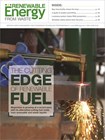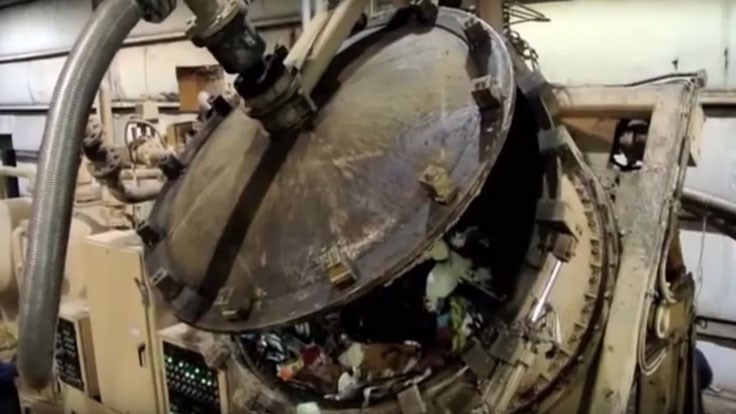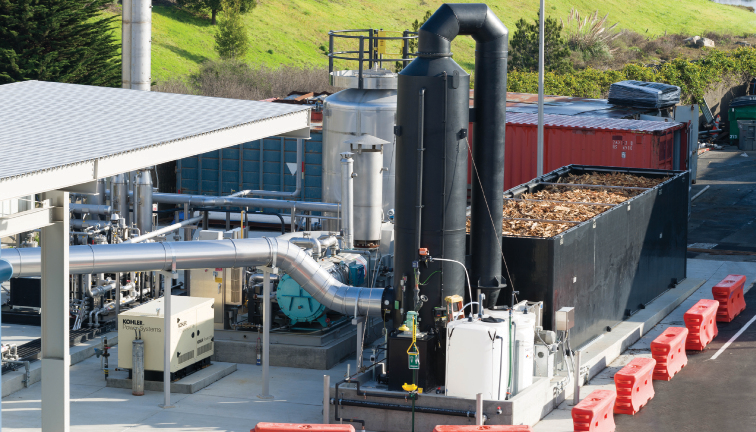
South San Francisco Scavenger Co. (SSFSC), based in South San Francisco, California, started out like most other waste collection facilities, but with the opening of its Blue Line Biogenic CNG Facility in February 2015, it is rapidly moving ahead of the pack.
The company opened in 1914 to collect waste and recyclables. By the early 1960s, it was operating a landfill owned by the city, which has since reached capacity and closed. Around 1970, the company opened Blue Line Transfer, a transfer station where trucks brought collected trash before taking it to another landfill.
Blue Line opened a materials recovery facility (MRF) in the early 1980s for sorting recyclables. It wasn’t until 2000 when both companies were combined into one 11-acre site. SSFSC still transfers solid waste to a landfill, but its main focus has become materials recovery.
“We’ve been a collection company for years but we’ve always scavenged through the garbage looking for valuable things before we threw them away,” says Doug Button, president of SSFSC. “Since we never owned a landfill, we always tried to divert as much as we could. We moved from a little bit of sorting to mostly sorting.”
With a little over 100 employees, SSFSC serves three cities, operates about 40 collection trucks with 25,000 residential and 1,800 commercial accounts, including the San Francisco International Airport.
DISCOVERING CNG
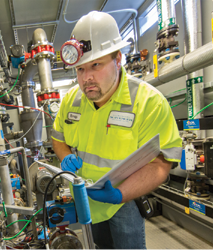
In 2006, the company had reached 50 percent diversion rate by recycling newspapers, bottles and cans. With the passing of a bill by then governor Arnold Schwarzenegger, California Senate Bill 375—which called for the elimination of organics from landfill, a sharp greenhouse gas reduction and a low-carbon fuel standard that would reduce fueled fleets by 10 percent—the company took a look at its carbon emissions and decided to go with a different standard.
After doing some research, SSFSC discovered that 84 percent of its carbon emissions came from its transfer vehicles, and after additional research on fueling alternatives, Button discovered compressed natural gas (CNG).
“We started looking into a solution for organics,” says Button. “[Whether or not] we should go to a compost site, but there aren’t a lot in California. We starting looking at alternatives and found anaerobic digestion.”
Button says he caught wind that Zero Waste Energy (ZWE), Lafayette, California, was building an anaerobic digestion system in San Jose, California. He went out to San Jose and inquired about the systems to make gas. Before he knew it, he was on a plane.
“We went to Europe, looked at the [technology] that was there, came back and evaluated if what they did in Europe would work here,” Button recalls. “[ZWE’s] Smartferm technology has modular systems that we could size to our needs. They had the right solutions.”
From there, Button says, “We literally took three separate, individual things—a digester, a cleanup system and a gas/fueling station—and put them all together.”
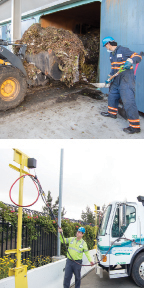
ZWE’s Smartferm technology is a dry AD system that processes organic waste feedstocks and generates methane to be converted into electricity or renewable natural gas (RNG) as well as compost.
The systems can process biogas into combined heat and power (CHP) generation as well as CNG.
The SSFSC’s Blue Line Biogenic CNG Facility is now making 300 to 500 gallons of CNG per day through with the system. It is designed to process organic waste streams with as much as 30 percent contamination of nonorganics and breaks down organic waste as well as other biodegradable products.
Through experimentation, the company discovered that food waste makes more gas than green waste. “Kind of like us,” Button says.
After the waste is sorted in the MRF, it is inspected for contaminants at the Blue Line CNG Facility. When the material is loaded into the digesters, air is supplied to the waste through an in-floor aeration system, which supplies oxygen to the waste. It is designed to rapidly and evenly heat the materials to process temperatures of between 125 and 131 degrees Fahrenheit. The exhaust air is treated in a biofilter to remove odor.
An inoculant or percolate is sprayed on the organic material, which then creates a biogas that is captured and mixed in a percolate tank before being stored in an above-ground storage bladder. The digestate that remains after the fermentation process is treated for up to five days in two in-vessel composting (IVC) tunnels that strip residual ammonia from the digestate to control odor and accelerate the compost maturation process.
Between 60 to 70 percent of the lean gases are made of methane and sent to the storage tanks. The other lean gases are routed to a boiler that uses 30 percent of the gas to burn the percolate.
“Our AD is making gas 24 hours, seven days a week, 365 days per year,” Button says. “[At first] we were a little leery because we tried propane back in the 70s and it didn’t work out, but this did and we’ve been expanding ever since.”
SSFSC uses between 1,200 to 1,500 diesel gallon equivalents of CNG to fuel 16 to 18 vehicles daily. Currently about 22 of its 40 vehicles are running on CNG. “As our fleet ages, we replace them,” says Button.
The trucks go out Monday through Friday to collect. At the end of a driver’s shift, the driver pulls his or her vehicle up to the station and plugs it in for fueling.
The digestion facility has allowed the company reduced its carbon emissions to the negatives—in fact, the company recently applied for -22.93 carbon intensity scale rating. “We have the only negative fuel,” Button says. “That’s cool stuff.”
PART OF THE SOLUTION
Competition isn’t the biggest concern for SSFSC. While landfill and composting facility charges can still be competitive, Button says his profits are still coming in.
“If I put 100 tons of food waste or yard waste in my digester, I’m only hauling 48 tons after 21 days. The bugs are eating 52 percent of it,” Button says. “When we started this, diesel was $5 per gallon, so it was profitable for me to use this.”
“You’re either part of the solution or you’re on the menu.” – Doug Button, president, South San Francisco Scavenger
The digestate that comes out of the system takes less than a month to transform into compost—a process that usually takes five months, according to Button.
“We’re probably the only company around here that’s going to have this [technology] for a long time and I think that gives us a competitive edge,” he says.
The biggest concern, according to Button, is the way we treat our environment. From his information gathering and implementation, Button learned the importance of reducing carbon emissions and using what is available as an alternative to fuel.“I don’t want to be the only one doing this because it’s good for us, our community, our children,” Button says. “Garbage companies, 20 years ago, were attacked as only interested in filling landfills, and that’s so untrue.”
He adds, “Rather than being portrayed as the problem, we want to say that we’re being part of the solution. You’re either part of the solution or you’re on the menu.”

